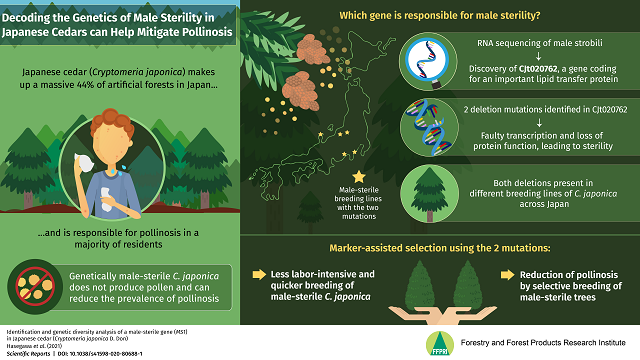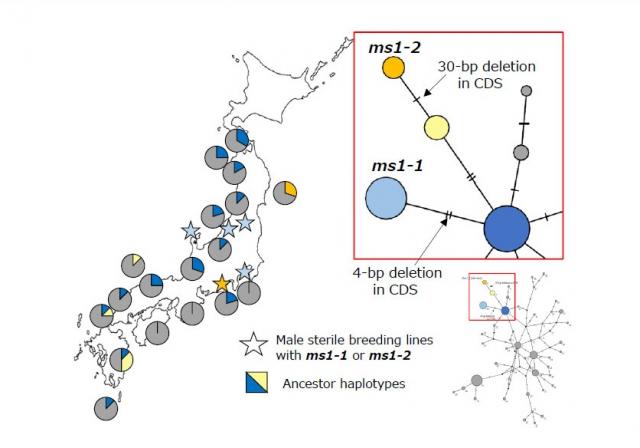Home > Research > Research Results > Research Results 2021 > A (Pollen-free) Sigh of Relief for Japan: The Genetics of Male Sterility in Cedar Trees
Update:February 16, 2021
Main content starts here.
![]()
February 16,2021
A (Pollen-free) Sigh of Relief for Japan: The Genetics of Male Sterility in Cedar Trees
New study reveals that selective breeding of male-sterile Japanese cedar trees using genetic screening can help reduce pollen load and associated allergies
Pollen from Cryptomeria japonica, or Japanese cedar, is widely known to cause allergies. But, male-sterile trees are known to be devoid of pollen. Now, researchers from the Forestry and Forest Products Research Institute, Japan, have studied the genetic variations in the male sterility gene (MS1) in these trees. This can help in selectively breeding male-sterile plants to counter the discomfort caused by pollen allergies and overcome the need to stay indoors during the pollen season.

Cryptomeria japonica, or the Japanese cedar, is highly revered as the national tree of Japan. Locally known as “sugi,” it covers over 4.5 million hectares of land, accounting for nearly half of Japan’s artificial forests. However, it is also notorious for causing hay fever, with a good 26.5% of Japan’s population reporting cedar pollen allergies in 2008. Over the past years, pollen allergy caused by this conifer has become a widespread social issue among Japanese residents, with many having to avoid going outdoors during pollen season.
As sterile trees cannot produce and release functional pollen, it is believed that breeding of male-sterile cedar trees could be crucial in reducing the pollen released into the environment. However, their frequency is drastically low, with only two male-sterile trees per 8700 trees in a forest! The rarity of these trees, combined with the large and repetitive genomes of conifers, has made decoding the genes involved in their reproduction (and the lack thereof) a challenge.
Recently, a team of researchers including Dr. Yoichi Hasegawa, Dr. Fu-Jin Wei, and Dr. Saneyoshi Ueno from the Forestry and Forest Products Research Institute (FFPRI) in Japan, along with Dr. Yoshinari Moriguchi from Niigata University, identified a candidate for the “Male Sterility” (MS1) gene in C. japonica and investigated the applications of selectively breeding male-sterile trees as a means to reduce the pollen load. Their findings have been published in the journal Scientific Reports.
Discussing their findings, Dr. Hasegawa says, “We have identified a candidate gene and two deleterious mutations underlying male sterility in sugi trees. The mutants can be easily detected using polymerase chain reaction (PCR) at the seedling stage without observing tree phenotypes (the outward appearance or manifestation), thereby accelerating the breeding of male-sterile sugi.”
The team first examined genetic mutations in trees with ms1 alleles from strobili, the cone-like structures that bear pollen, using RNA sequencing analysis. The recessive “allele” (one of the two inherited “copies” of a gene), “ms1,” has been associated with male sterility in Japanese cedars because it causes defective formation of microspores—the male gamete required for breeding. They identified a candidate gene for male sterility, called CJt020762. They also identified two deletion mutations within this gene that were consistently found in male-sterile trees. Using these two mutations as markers, the team developed a simple PCR-based screening strategy to detect these mutations and rapidly propagate male-sterile seedlings.
Further, Dr. Hasegawa and his team established a “haplotype network” with trees across 18 natural forests in Japan. Describing how the pattern and variation of genetic alterations in the specified gene influence ancestry, Dr. Hasegawa states, “Phylogeographic analysis of the mutants demonstrates that they share a close common ancestor whose haplotype is distributed throughout Japan, suggesting that new breeding materials with the mutant haplotype will be found in various regions under different environmental conditions.”
Their findings provide useful insights into the molecular mechanisms underlying male sterility in conifers and highlights the importance of genetic markers in pollen production. With the help of these markers, selective breeding of male-sterile trees could gradually but eventually replace fertile conifers in artificial forests. This has the potential to substantially reduce the amount of dispersed pollen and the allergies associated with it.
In conclusion, Dr Hasegawa remarks, “Our study identifies the functional gene behind male sterility in conifers for the first time, establishing the model of reproductive genetics in sugi. Increased breeding of male-sterile sugi seedlings in the artificial forests will be easier using genetic screening, gradually replacing fertile trees with male-sterile ones. Probably in the next 50 years, many people with pollen allergy will be relieved to step outdoors in spring owing to the increasing number of male-sterile cedar trees and the eventual decrease in airborne pollen.”
The study is indeed a step forward towards carefree—and pollen-free—breathing for people in Japan and even the world over!

Geographical distribution and the haplotype network for MALE STERILITY 1 candidate gene haplotypes
Image courtesy: Yoichi Hasegawa from Forestry and Forest Products Research Institute
Reference
Title: Identification and genetic diversity analysis of a male sterile gene (MS1) in Japanese cedar (Cryptomeria japonica D. Don)
Published in: Scientific Reports
DOI: 10.1038/s41598-020-80688-1
About Dr. Yoichi Hasegawa from Forestry and Forest Products Research Institute, Japan
Dr. Yoichi Hasegawa is currently a senior researcher at the Tree Genetic Lab in Forestry and Forest Products Research Institute, Japan. His research interests include the identification and characterization of genetic markers in plants and marker assisted selection of reproductive traits and pollen production. Dr. Hasegawa has authored several publications in peer reviewed journals in the area of plant genetics.
Funding information
This study was supported by research grants #201421 from the Forestry and Forest Products Research Institute, Grant-in-Aid from the Program for Promotion of Basic and Applied Researches for Innovations in Bio-oriented Industry (No.28013B), the project of the NARO Bio-oriented Technology Research Advancement Institution (Research program on development of innovative technology, No.28013BC), and NIBB Collaborative Research Program (16-403, 17-405 and 18-408).
Media contact: Saneyoshi Ueno (saueno@ffpri.affrc.go.jp)
Copyright © Forest Research and Management Organization. All rights reserved.
